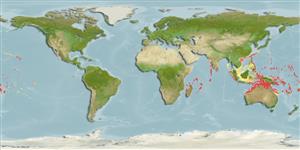Common names from other countries
>
Eupercaria/misc (Various families in series Eupercaria) >
Labridae (Wrasses)
Etymology: Labropsis: Greek, labrax, -akos = a fish, Dicentrarchus labrax + Greek,opsis = appearance (Ref. 45335).
More on author: Randall.
Environment: milieu / climate zone / depth range / distribution range
Écologie
marin récifal; profondeur 0 - 55 m (Ref. 2334), usually 7 - 55 m (Ref. 27115). Tropical; 24°C - 27°C (Ref. 27115); 33°N - 24°S
Indo-Pacific: East Africa to American Samoa, north to Izu Islands, south to the Great Barrier Reef.
Taille / Poids / Âge
Maturity: Lm ? range ? - ? cm
Max length : 13.0 cm TL mâle / non sexé; (Ref. 2334)
Épines dorsales (Total): 9; Rayons mous dorsaux (Total): 11; Épines anales 3; Rayons mous anaux: 10. Scales on lateral line: 46-49 (+2 past hypural) (Ref. 1602). Juveniles are black with several white pinstripes; females become lighter dorsally, and males develop golden centered scales, blue lines on the face, and a wedge-shaped white area in the center of the tail (Ref. 1602).
Uncommon inhabitant of coral-rich areas of clear outer lagoon and seaward reefs (Ref. 1602). May form small groups (Ref. 90102). Males generally solitary (Ref. 9710). Juveniles are cleaners while adults feed on coral polyps (Ref. 1602). Minimum depth reported taken from Ref. 128797.
Life cycle and mating behavior
Maturité | Reproduction | Frai | Œufs | Fécondité | Larves
Oviparous, distinct pairing during breeding (Ref. 205).
Randall, J.E., G.R. Allen and R.C. Steene, 1990. Fishes of the Great Barrier Reef and Coral Sea. University of Hawaii Press, Honolulu, Hawaii. 506 p. (Ref. 2334)
Statut dans la liste rouge de l'IUCN (Ref. 130435)
CITES (Ref. 128078)
Not Evaluated
Menace pour l'homme
Harmless
Utilisations par l'homme
Aquarium: Commercial
Plus d'informations
RéférencesAquacultureProfil d'aquacultureSouchesGénétiqueElectrophoresesHéritabilitéPathologiesTraitementMass conversion
CollaborateursImagesStamps, Coins Misc.SonsCiguateraVitesseType de nageSurface branchialeOtolithesCerveauxVision
Outils
Articles particuliers
Télécharger en XML
Sources Internet
Estimates based on models
Preferred temperature (Ref.
115969): 25.9 - 28.8, mean 27.6 (based on 554 cells).
Phylogenetic diversity index (Ref.
82804): PD
50 = 0.5156 [Uniqueness, from 0.5 = low to 2.0 = high].
Bayesian length-weight: a=0.00912 (0.00472 - 0.01763), b=3.06 (2.90 - 3.22), in cm Total Length, based on LWR estimates for this species & (Sub)family-body (Ref.
93245).
Niveau trophique (Ref.
69278): 2.9 ±0.55 se; based on food items.
Résilience (Ref.
120179): Haut, temps minimum de doublement de population inférieur à 15 mois (Preliminary K or Fecundity.).
Fishing Vulnerability (Ref.
59153): Low vulnerability (10 of 100).
